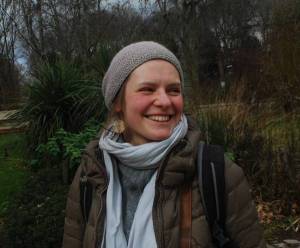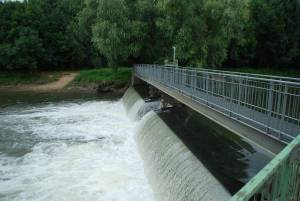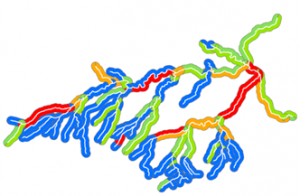Freshwater Ecologist
RiverLy, EcoFlowS
Tel: (+33) 4 72 20 87 96
Email : maria.alp at inrae.fr
ORCID ID : 0000-0003-4295-6361
Key research topics and activities
Human impact on freshwater ecosystems
Animal dispersal and recruitment in stream network
- Landscape connectivity for aquatic and terrestrial life stages of aquatic organisms https://www.seine-aval.fr/projet/anacondha/
- Population genetics (fish, macroinvertebrates) of stream populations
- Emergence of life history bottlenecks for freshwater species with complex life cycles (aquatic insects, migratory fish)
Functional ecology
- Cross-ecosystem links (subsidy ecology)
- Stable isotope use in evaluating human impact on freshwater food webs
Restoration ecology: combining social and ecological goals
- Socio-ecological effects of river connectivity restoration
- Knowledge transfer from research to practitioners
Student supervision
Master students
Emmanuel Jaulin, 2021 (Université de Rennes I) From emergence to oviposition of mayflies: Description of the oviposition behaviour and assessment of dispersal distances.
Emilie Mauduit, 2019 (Université de Poitiers) Spatio-temporal patterns of mobility of resident river trout, Salmo trutta fario: combination of telemetric and genetic data.
Alexia Mustarda, 2018 (Université Claude Bernard Lyon I) Analyse de viabilité des populations: construction d’un modèle de dynamique de populations de truites dans un cours d’eau pyrénéen.
Doctoral theses
Emmanuel Jaulin, 2022-2024 (University Lyon I) Looking at early stages of aquatic organisms to improve our understanding of ecological effects of hydropeaking.
Other responsibilities
- Member of the Scientific Committee of the Parc National de Forêts
- Co-coordinator of the Ecological Restoration network within INRAE
- Reviewer for: Freshwater Biology, Aquatic Sciences, Aquatic Ecology, Freshwater Science, Hydrobiologia, Diversity and Distributions, The Biological Journal of the Linnean Society, Limnologica, Biotropica, Ecology, Molecular Ecology, PeerJ, Frontiers in Environmental Science
- Project evaluation for the Czech Science Foundation
Peer-reviewed publications
Alp, M., Batalla, R.J., Bejarano, M.D., Boavida, I., Capra, H., Carolli, M., Casas-Mulet, R., Costa, M. J., Halleraker, J.H., Hauer, C., Hayes, D.S., Harby, A., Noack, M., Palau, A., Schneider, M., Schönfelder, L., Tonolla, D., Vanzo, D., Venus, T., Vericat, D., Zolezzi, G., & Bruno, M.C. (2022). Introducing HyPeak: An international network on hydropeaking research, practice, and policy. River Research and Applications, 1– 9. https://doi.org/10.1002/rra.3996
Alp, M., & Cucherousset, J. (2021). Food webs speak of human impact: Using stable isotope-based tools to measure ecological consequences of environmental change. Food Webs, e00218. https://doi.org/10.1016/j.fooweb.2021.e00218
Downes, B. J., Peckarsky, B. L., Lancaster, J., Bovill, W. D., & Alp, M. (2021). From insects to frogs, egg–juvenile recruitment can have persistent effects on population sizes. Annual Review of Ecology, Evolution, and Systematics, 52. https://www.annualreviews.org/doi/abs/10.1146/annurev-ecolsys-122420-102909
Sarremejane, R., Cid Puey, N., Datry, T., Stubbington, R., Alp, M., Cañedo-Arguelles, Cordero-Rivera, M.A., Csabai, Z., Gutierrez Canovas, C., Heino, J., Forcellini, M., Millan, A., Paillex, A., Paril, P., Polasek, M., Tierno de Figueroa, J.M., Usseglio-Polatera, P., Zamora-Muñoz, C., Bonada, N. (2020) DISPERSE: A trait database to assess the dispersal potential of aquatic macroinvertebrates. https://www.biorxiv.org/content/10.1101/2020.02.21.953737v1
Alp, M., Le Pichon C. (2020) Getting from sea to nurseries: considering tidal dynamics of juvenile habitat distribution and connectivity in a highly-modified estuarine riverscape. Ecosystems. https://doi.org/10.1007/s10021-020-00536-1
Alp, M., Cucherousset, J., Buoro, M., Lecerf, A. (2016) Phenological response of a key ecosystem function to biological invasion. Ecology Letters, 19(5), 519-527. https://doi.org/10.1111/ele.12585
Kaboré I., O. Moog, M. Alp, W. Guenda, T. Koblinger, K. Mano, A. Ouéda, Ouédraogo R., D. Trauner and A.H. Melcher. (2016) Using macro-invertebrates for ecosystem health assessment in semi-arid streams of Burkina Faso. Hydrobiologia, 766(1), 57-74. https://doi.org/10.1007/s10750-015-2443-6
Larsen S. & Alp M. (2015) Ecological thresholds and riparian wetlands: an overview for environmental managers. Limnology, 16 (1), 1-9. https://doi.org/10.1007/s10201-014-0436-1
Pauls, S.U., Alp, M., Balint, M., Bernabo, P., Čiampor, F., Čiamporová-Zaťovičová,Z., Finn, D., Kohout, J., Leese, F., Lencioni, V., Paz-Vinas, I. & Monaghan, M.T. (2014) Integrating molecular tools into freshwater ecology: developments and opportunities. Freshwater Biology, 59: 1559–1576. https://doi.org/10.1111/fwb.12381
Alp M., Peckarsky, B.L., Bernasconi, S.M., Robinson C.T. (2013) Shifts in isotopic signatures of animals with complex life-cycles can complicate conclusions on cross-boundary trophic links. Aquatic Sciences, 75(4): 595-606. https://doi.org/10.1007/s00027-013-0303-x
Alp, M., Indermaur, L., Robinson, C.T. (2013) Environmental constraints on oviposition of aquatic invertebrates with contrasting life cycles in two human-modified streams. Freshwater Biology, 58: 1932-1945. https://doi.org/10.1111/fwb.12181
Alp M., Westram A.M., Keller, I., Robinson C.T. (2012): How river structure and biological traits influence gene flow: a population genetic study on two stream invertebrates with differing dispersal capacity. Freshwater Biology, 57 (5), 969-981. https://doi.org/10.1111/j.1365-2427.2012.02758.x
Gostner W., Alp M., Schleiss A., Robinson C.T. (2012): A new hydro-morphological index of diversity for assessing the physical potential for river health. Hydrobiologia, 712(1): 43-60. https://doi.org/10.1007/s10750-012-1288-5
Alp M. (2011) Integrating terrestrial stages of aquatic insects into studies of dispersal and recruitment in streams. PhD Thesis, ETH Zurich. https://www.research-collection.ethz.ch/handle/20.500.11850/153323
Reports and publications without peer-review process (in German/French)
Le Pichon C., Alp, M. (2018) Projet ANACONDHA « Analyse spatiale de la connectivité des habitats fonctionnels pour les poissons à l’échelle de l’estuaire ». Rapport de recherche du programme Seine Aval 5. https://www.seine-aval.fr/projet/anacondha/
Alp M., Karpati T., Werth S., Gostner W., Scheidegger C., Peter A. (2011): Erhaltung und Förderung der Biodiversität von Fliessgewässern. Wasser, Energie, Luft, 103 (3), 216-223. https://issuu.com/swv_wel/docs/wel_3_2011?backgroundColor=%2523222222
Werth, S., Weibel, D., Alp, M., Junker, J., Karpati, T., Peter, A. & Scheidegger, C. (2011) Lebensraumverbund Fliessgewässer: Die Bedeutung der Vernetzung. Wasser, Energie, Luft, 103 (3), 224-234. https://issuu.com/swv_wel/docs/wel_3_2011?backgroundColor=%2523222222
Recueil des fiches sur l’aménagement et l’écologie des cours d’eau (2012) Office fédéral de l’environnement OFEV, Berne, Suisse (FRA) / Merkblatt-Sammlung Wasserbau und Ökologie, Bundesamt für Umwelt BAFU, Bern, Schweiz (DE).
Werth, S., Alp, M., Karpati, T., Gostner W., Scheidegger, C., Peter, A. (2012) Fiche 2: Biodiversität in Fliessgewässern / Merkblatt 2: Biodiversité dans les cours d’eau.
Werth, S., Alp, M., Junker, J., Karpati, T., Weibel D., Peter, A., Scheidegger, C. (2012): Fiche 4: Connectivité des cours d’eau / Merkblatt 4: Vernetzung von Fliessgewässern.







